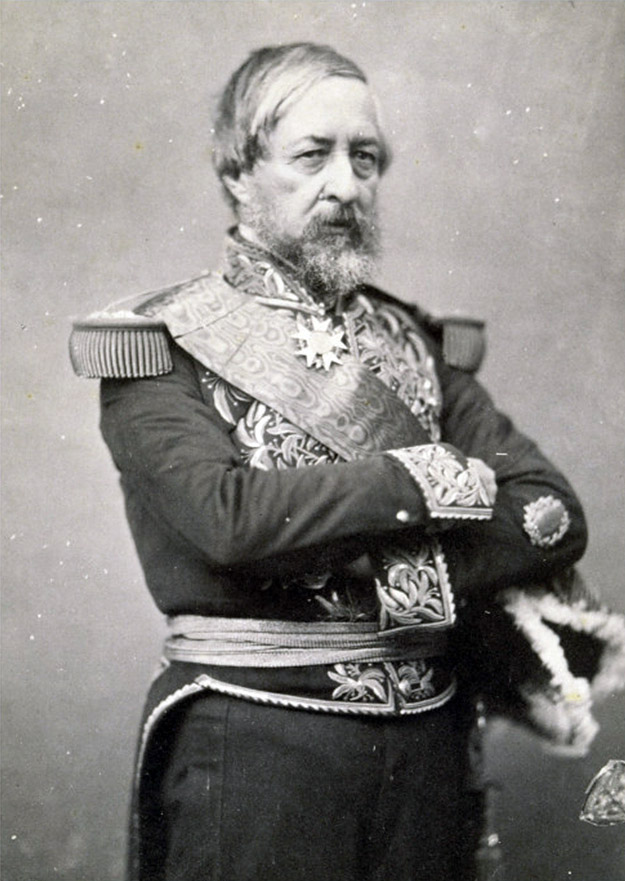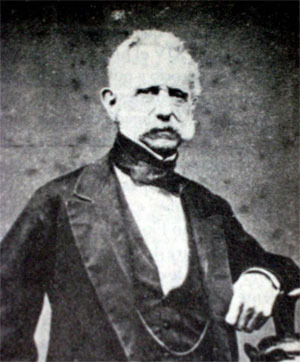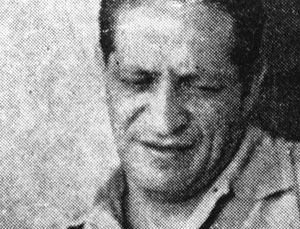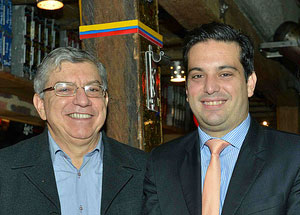Founded in 1848, Colombia’s Liberal Party has been one of the prominent political organizations since the 19th century. It has shared power and conflict with Colombia’s Conservative party for over 150 years.
Birth of the party
The party came into its own under General Jose Hilario Lopez with the premise of greater liberty for the Colombian people, similar to those that had emerged in England during the Enlightenment period..
The party has traditionally focused on more urban areas where issues of industrialization and labor are most common. It has also focused on promoting social welfare programs.
One of the earliest key elements of the Liberal platform was an “anticlerical” stance as it promoted a separation of church and state instead of the Conservative-supported tradition of intimately intertwining the two previously favored by Liberator Simon Bolivar.
Colombia’s first liberal president
The year 1849 saw Lopez elected the first Liberal president and the beginning bipartisan political schism which would lead to numerous civil conflicts in Colombia. Unfortunately, his presidency did not see as much success as the party hoped for.
Liberals were unable to really do away with a lot of the traditional instruments benefiting the wealthy and, in some case, even further benefited them.
Even the abolition of slavery, itself a worthy goal, was of limited political value since Colombia’s slave population at the time was relatively low.
The election of 1853, only five years after the party’s beginning, saw the Liberal party split among three groups. These splits would, like many other political parties, be recurring and would prove to be significant weak points for the Liberals.
At this time, the party was split between the Radicals (social liberals); the Golgothas (young progressive liberals) and the Draconians (old liberal elite).
Liberals take full political control
Fortunately for the liberals, the Conservative party abstained from the election and Jose Maria Obando, representing the Draconians, won the election. His administration, despite his own misgivings and the dissent of his supporters, ratified the 1853 Constitution.
This Constitution provided for great strides in the Liberal direction, officially abolishing slavery and extending suffrage to married men 21 years old and up.
It placed the church under civilian jurisdiction (for the purpose of civil law) and made the elections of governors, magistrates, congressmen, the vice president, and the president a process of direct popular vote.
Jose Maria Obando was deposed in a bloodless military coup after just one year in office as the result of the “Artisans Revolution.” After his deposition the presidency briefly passed to General Jose Maria Melo who abdicated power back to the administration and with the vice president as Acting President until the next election when Conservatives gained the presidency in 1857.
Colombian Civil War (1860-62)
At the time, Colombia was a federation and consisted of several separate states that were governed through the Congress of Colombia. Under the presidency of Mariano Ospina Rodriguez Conservatives tried to centralize government control to Bogota.
The congress passed legislation to allow the president to direct the resources and governments of the separate states and the power to remove state governors. This led to unrest and Liberal party leader Tomas Cipriano de Mosquera gained enough support to declare the Sovereign State of Cauca to be a separate nation, starting a civil war.
The Liberals emerged victorious on November 12, 1862. Colombia had shifted to The United States of Colombia and a succession of Liberal presidencies began. The period would be known as the “Epoch of Civil Wars” because almost one quarter of the 240 months of Liberal reign would see some form of conflict.
Tomas Cipriano de Mosquera served the first presidency, which was marked by his strict handling of the church. Jesuit supporters of the Conservative party were banned from the country and church properties were seized by the administration and sold to benefit the Colombian people.
He would return for a second presidency, for a total of three terms (plus one much earlier in 1845-49). The period saw some progression in education under Santiago Perez.
Liberals fall apart
1876 saw another notable schism within the Liberal party, splitting the party in two. The Conservatives took advantage of this and launched an offensive, initiating another civil war.
This resulted in the Conservative-supported Liberal presidency of Rafael Nuñez who initiated the Regeneration and successful passed the 1886 Constitution, officially making Colombia the Republic of Colombia.
Though there were three more Liberal presidencies after this, Nuñez’ first term ushered in a 55-year period of Conservative, or at least Conservative-supported, governance called “The Conservative Hegemoney.”
The War of a Thousand Days
In 1899 another war broke out between the Conservative and Liberal parties. This war cost between 60,000 – 130,000 lives.
Conservative policies had led to coffee plantation owners operating on a loss on the market. Liberals took up arms in support of plantation owners and import-export merchants hoping for more representation in government and the ability to obtain a laissez-faire economy. Guerrilla warfare dominated for over a thousand days until June 12, 1902.
Liberals were unable to achieve victory this time but Conservatives could not fully quell the dissent. The government offered amnesty and some reform, and a cessation of fighting was agreed to.
From 1905 to the late 1920s, exports boomed with Colombian coffee providing almost 10% of the world’s market supply. Petroleum and banana exports also picked up, leading to an increase in domestic development for the country.
The Great Depression’s transnational impact had a strong and immediate impact on a now export-focused Colombian economy, significantly weakening the dominance of Conservative government. The Liberal party was poised to take the reigns once more.
The Liberal Republic: 1930-46
Conservatives’ use of the military against banana industry labor unions helped set the stage for another period of Liberal leadership through the duration World War II.
The hallmark during this period was under the presidency of Alfonso Lopez Pumarejo. Liberals established “effective occupancy” as the basis for tenure, legally empowering thousands of families of squatter peasants to maintain their homes against the pressures of wealthy landowners.
Liberal Republic Presidents
Enrique Olaya
(1930 – 1934)
Alfonso Lopez
(1934 – 1938)
Eduardo Santos
(1938 – 1942)
Alfonso Lopez
(1942 – 1946)
The violent repression, unrest among Colombia’s mostly poor population and an increasingly popular Liberal Party put the Conservatives under pressure. Due to internal divisions, the party ran two candidates in the 1930 election.
Receiving less votes than the two Conservative candidates combined but substantially more than either one of them, Liberal candidate Enrique Olaya took control of government in what is called the beginning of “The Liberal Republic,” during which the Liberal Party controlled both Congress and the Presidency and pushed far-stretching liberal reforms further polarizing the Conservative Party.
Conservative Party leader Laureano Gomez was almost immediately appointed ambassador to Berlin where he was witness to the rise of Adolf Hitler and his National Socialism, something that would later reemerge on his return to Bogota when he and political allies tried to organize a repetition of the 1938 “Kristallnacht,” during which Nazi supporters in Germany coordinately assaulted Jews and Jewish property.
But meanwhile in Bogota, the Liberals strengthened their control over the government. Following accusations of electoral fraud in the 1933 congressional elections and a no right to free election, the Conservative Party refused to take part in the 1934, 1938 and 1842 presidential elections, and the 1935 and 1937 congressional elections, leaving the conservatives out of Congress since it’s foundation.
Having no opposition, Liberal President Alfonso Lopez pushed through far-fetching constitutional amendments which included the right to citizenship for women, the right for workers to form unions, and the abolishment of Catholicism as state religion. Instead, Colombians were granted the freedom to religion, much to the discontent of the Catholic Church and the Conservative Party in 1936.
The Violence
When in 1946 supporters of the moderate Gabriel Turbay and the more radical Jorge Eliecer Gaitan again split Liberal unity, the Conservatives were again able to regain control.
However, there was a political block as Liberals controlled the Congress. Under the presidency of Mariano Ospina, Gaitan became immensely popular and his electoral support threatened the leadership of both the Conservative government and the Liberal Party.
Many have argued that he was destined to be the next president, and a highly popular one, but it was not to be: Gaitan was assassinated in broad daylight in downtown Bogota on April 9, 1948.
Gaitan’s assassination sparked the “Bogotazo,” rioting in the streets of Bogota. This would mix with rural fighting, which was already present but grew exponentially, to create over a decade of conflict and bloodshed called “La Violencia.”
This was not another Civil War, but an extended conflict between the Liberal and Conservative political parties parties through the medium of military and paramilitary forces. It is estimated that between 200,000 and 400,000 people were killed.
The political war was characterized by the intense cruelty each party exhibited regarding each other. There were even accusations of priests, supporting the church-friendly Conservatives, telling their parishioners that they could kill a certain amount of Liberals and still be permitted into heaven.
The resulted in the Liberal party no longer having enough people to pose a political challenge to the Conservatives. Military leaders replaced the holes left by the Liberals and cooperated with the Conservatives to establish the Conservative presidency of President Laureano Gomez in 1950. However, the violence increased even more after Gomez took office, after which the liberal-leaning General Gustavo Rojas, overthrew and exiled the conservative president and established a military junta.
National Front

The military junta worked to bring Liberals and Conservatives together. With support from dissident military sectors the two parties established the “National Front,” a bipartisan deal in which the Liberals and Conservatives agreed to rotate the presidency. They also agreed to equally divide seats in the cabinet, national legislature, provincial assemblies, and municipal councils.
While the pact had problematic implications for Colombian democracy, it did end the mass killings and normalized Colombia’s society. The agreement lasted through four terms until democracy was reestablished in 1978. It also marked the last time Conservatives would enjoy political dominance.
Political control since 1810

Enter the narcos
Since the end of the the National Front, Liberals held firmly onto the reigns of power until 2002, winning five of the seven presidencies during that period.
However, this period of Liberal leadership was marred and characterized by the explosive growth of Colombia’s drug trade and an inability to address the growing problems caused by leftist rebel forces like the FARC and ELN.
Presidencies were defined by how they handled the violence and legal issues presented by these actors. Politicians taking a hard-liner approach would lose popularity as guerrillas and/or drug traffickers responded violently to strict policies. Politicians who took less hard approaches risked appearing weak or being suspected (or guilty) of corruption.
Some Liberal Party politicians sought alliances with drug traffickers to increase their power. Slain drug lord Pablo Escobar even briefly made it to Congress in the 1980s with the help of Liberal congressmen.
However, the same Pablo Escobar in 1989 ordered the assassination of one of the party’s most charismatic leaders, Luis Carlos Galan, who was threatening to combat drug trafficking and remove control over the party from the hands of the traditional clans.
Escobar ordered the killing at the request of traditional Liberal party mogul Alberto Santofimio, a close ally of liberals Ernesto Samper and Horacio Serpa who would become President and Interior Minister respectively in 1994.
Shocked by Galan’s death, Colombia elected Liberal Cesar Gaviria president. The former Galan aide claimed the victory of finally stopping Pablo Escobar, who was gunned down by police in 1993. However, that same administration had been responsible for allowing Escobar to live in his own luxurious self-built prison from where he safely ran his drug empire.
The last Liberal president
Colombia’s last Liberal presidency, that of Samper (1994-1998), was marred by a scandal in which was proven that Samper’s presidential campaign had been funded by the Cali Cartel. The scandal broke only five years after another drug lord, Escobar, killed Galan.
The scandal’s investigation found that the campaign had received more than $6 million from the Cali drug cartel in order to ensure a narrow margin of victory over the Conservative candidate Andres Pastrana.
The ensuing turmoil resulted in several members of the administration being charged and defense minister Fernando Botero, son of the painter of the name name, was sent to prison. Samper loyalist Horacio Serpa was able to beat the charges and became Interior Minister.
Prominent Conservative Party politician and one of the fiercest critics in the scandal, Alvaro Gomez, was assassinated by the Cali cartel in 1995.
Samper, as president, could only be tried for corruption by the Colombian Congress. Despite the evidence given against him, Serpa was able to convince the Liberal majority in Congress to precluded the case, judging neither guilty nor innocent of knowing about the cartel ties.
The United States was less easy to convince and Samper saw his US visa revoked and diplomatic ties with the north American ally nearly froze entirely.
Colombian election results since 1931
Disintegration of party structure
Following the 8000 scandal, the Liberal Party had lost a lot of the popular support it had enjoyed during and after Galan.
Additionally, the governments of Gaviria and Samper failed to adequately address the fact that guerrilla groups like the FARC and ELN had been growing extensively and were successfully expanding their territory to the extent that most major cities by the end of the 90s were surrounded guerrilla forces.
The fall of Bogota seemed only a matter of time and — faced with governmental inaction — paramilitary groups formed and began a violent campaign to curb the guerrillas’ territorial control of Colombia.
The Liberals lost the 1998 elections to the Conservative Party led by Andres Pastrana, who began peace talks with the FARC in order to avert a total collapse of the state. At the same time, Pastrana restored ties with the US to revamp the strategy to combat drug trafficking and the Marxist guerrillas.
Pastrana’s presidency was widely considered a failure though, especially after talks failed with the FARC and the fall of the state seemed inevitable.
Despite Pastrana’s failure, the Liberals were unable to resume power because of an internal division between loyalists of Samper and loyalists of a newly rising Liberal Party politician, former Governor Alvaro Uribe.
Liberals defect to Uribe camp
Just before the 2002 elections, Uribe left the Liberal Party over an ongoing feud with Samper-loyalist Horacio Serpa and blew up the party.
Powerful Liberal Party elite politicians like Juan Manuel Santos and German Vargas, both descendants of Liberal presidents, followed Uribe, leaving the party in shambles.
The “Uribistas” won the 2002 elections and the Liberal Party was forced into the opposition. For the first time since the dictatorship of Rojas in 1957, Colombia’s presidency was occupied by a politician who did not run with the institutional support of either the Liberal or Conservative Party.
Uribe was supported in Congress by the Conservative Party, Vargas’ Radical Change party and a patchwork of smaller political parties. These parties had mostly emerged from regional politician dynasties, some of which in collaboration with paramilitary organization AUC.
In 2005, Santos founded the U Party to form a less fragmented political support base for Uribe. When in 2010 Uribe was not allowed to run for a this term, Santos used the political apparatus for his own campaign.
The Liberal Party’s exclusion from power kept it out of the limelight when prosecutors began investigating the ties between the paramilitaries and politicians. However, parties that had aligned with Uribe were heavily damaged and in some cases even eliminated as dozens of congressmen were imprisoned over what became known as “parapolitics.”
While in the opposition, ex-President Gaviria resumed control over the party, and successfully re-united the families and regional dynasties that traditionally had supported the party.
The “parapolitics” scandal had weakened Uribe’s power base approaching the 2010 elections. Former Liberal Party politician Vargas, for example, saw his initial congressional representation cut in half over criminal investigations and withdrew his support for the president.
Liberals unite under Santos
Uribe unofficially endorsed Santos, his former Defense Minister, but saw himself marginalized after the newly elected president betrayed his former superior almost immediately after taking office.
Instead of granting government positions to politicians from Uribe’s political support base in the regions, Santos re-united the Liberal Party families from Bogota that had separated in 2001 and 2002.
Both the Conservative and Liberal Party joined Santos’ “Coalition of National Unity,” leaving Uribe loyalists out of the political machine.
At the end of Santos’ reign, the Liberal Party surprisingly supported “uribista” candidate Ivan Duque, a protege of Uribe.
The new president was not interested in sharing power though, and the Liberal Party declared itself formally independent of government, severely weakening Duque’s coalition in Congress.










